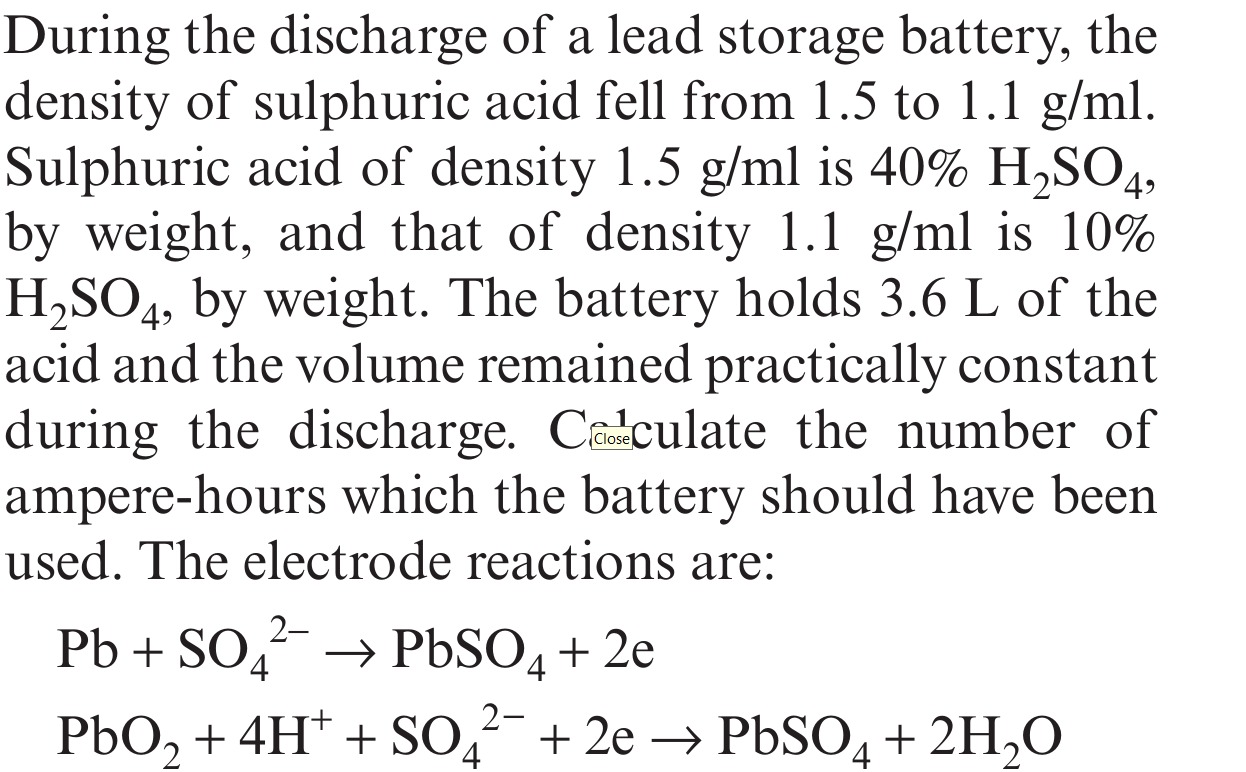Question
Question: During the discharge of a lead storage battery, the density of sulphuric acid fell from 1.5 to 1.1 g...
During the discharge of a lead storage battery, the density of sulphuric acid fell from 1.5 to 1.1 g/ml. Sulphuric acid of density 1.5 g/ml is 40% H2SO4, by weight, and that of density 1.1 g/ml is 10% H2SO4, by weight. The battery holds 3.6 L of the acid and the volume remained practically constant during the discharge. Calculate the number of ampere-hours which the battery should have been used. The electrode reactions are:
Pb+SO42−→PbSO4+2e
PbO2+4H++SO42−+2e→PbSO4+2H2O

A
482.5 Ah
B
241.25 Ah
C
965 Ah
D
1764 Ah
Answer
482.5 Ah
Explanation
Solution
- Calculate the initial and final mass of sulfuric acid (H2SO4) in the battery.
- Initial mass of solution = Initial density × Volume = 1.5 g/mL × 3600 mL = 5400 g.
- Initial mass of H2SO4 = 40% of 5400 g = 0.40 × 5400 g = 2160 g.
- Final mass of solution = Final density × Volume = 1.1 g/mL × 3600 mL = 3960 g.
- Final mass of H2SO4 = 10% of 3960 g = 0.10 × 3960 g = 396 g.
- Calculate the mass of H2SO4 consumed during discharge.
- Mass consumed = Initial mass - Final mass = 2160 g - 396 g = 1764 g.
- Calculate the moles of H2SO4 consumed.
- Molar mass of H2SO4 = 98 g/mol.
- Moles of H2SO4 consumed = Mass consumed / Molar mass = 1764 g / 98 g/mol = 18 mol.
- Determine the number of moles of electrons transferred.
- The overall discharge reaction is Pb+PbO2+2H2SO4→2PbSO4+2H2O.
- This reaction shows that 2 moles of H2SO4 are consumed for every 2 moles of electrons transferred. Therefore, 1 mole of H2SO4 consumed corresponds to 1 mole of electrons transferred.
- Moles of electrons transferred = Moles of H2SO4 consumed = 18 mol.
- Calculate the total charge passed in Ampere-hours (Ah).
- Total charge (Q) = Moles of electrons × Faraday's constant (F).
- Using F = 96500 C/mol.
- Q = 18 mol × 96500 C/mol = 1,737,000 C.
- To convert Coulombs to Ampere-hours, divide by 3600 (since 1 Ah = 3600 C).
- Charge in Ah = 1,737,000 C / 3600 C/Ah = 482.5 Ah.
